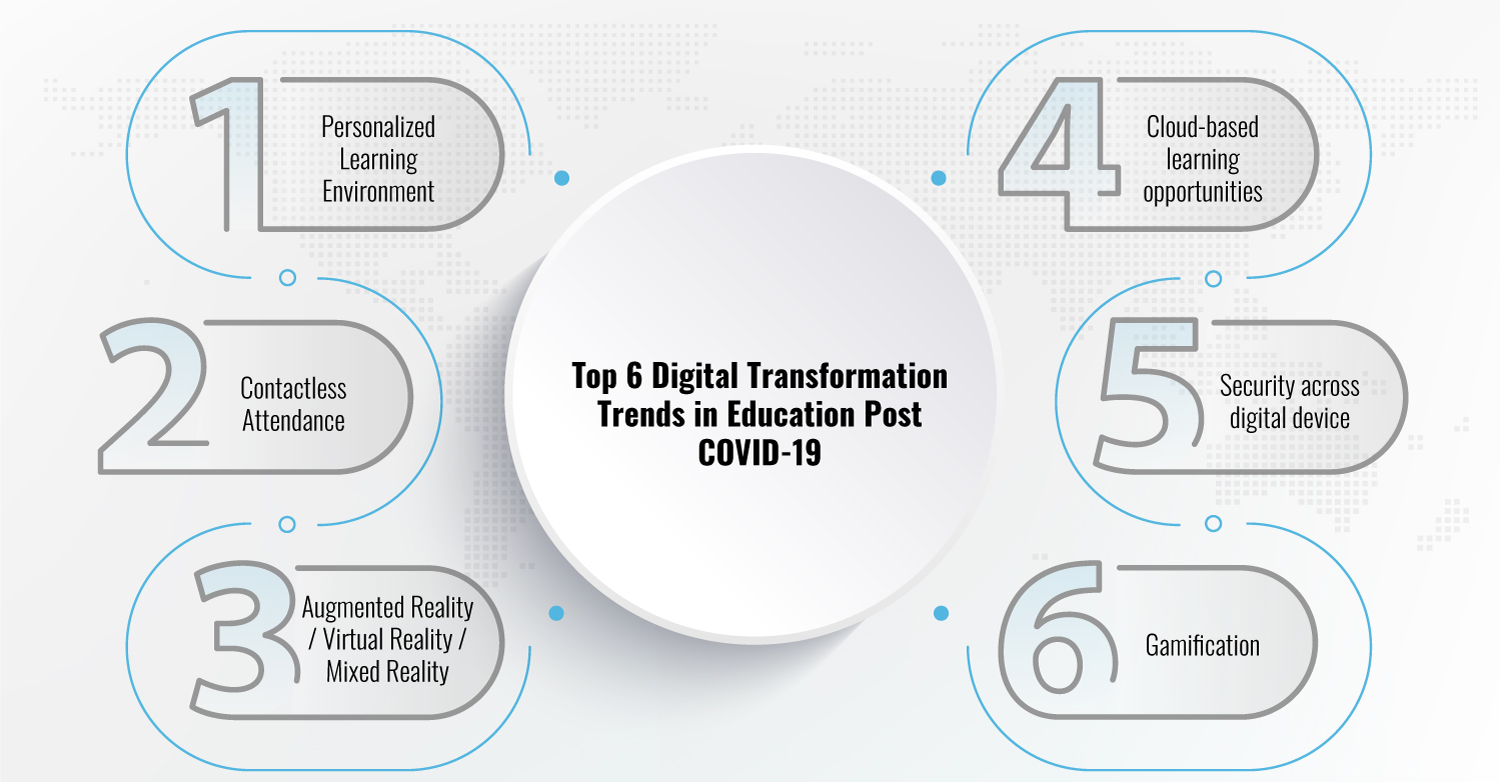Teachers and administrators are looking for ways to improve the educational experience as schools plan to re-open amid Covid-19. Education is largely a legacy sector, and it could take years to carry out large-scale transformations to practices, methods, and operations and completely transform how they function. But for now, tech-enabled education is greatly transforming schooling practices. We dive into what the tech-enabled education of the future could look like.
Top 6 Digital Transformation Trends in Education Post COVID-19
- Personalized Learning Environment
- Contactless Attendance
- Augmented Reality / Virtual Reality / Mixed Reality
- Cloud-based learning opportunities
- Security across digital devices
- Gamification
1. Personalized Learning Environment
Today, most students have easy access to technology tools that allows them to learn, assess, adapt, and challenge themselves at their own level. This model of personalized, independent learning for students is a great fit in the post-COVID-19 world. It helps students develop their self-learning capabilities.
With these tools, students can now make better decisions about their learning habits, and parents are more aware of how their children learn. Teachers can also provide more effective instruction to students when they engage in individualized learning, which benefits everyone involved. This approach has the most transformative aspect: students do not have to be in crowded classrooms to learn from these tools. Instead, students can learn at home or in the community. The teacher’s role is expanded. Instead of focusing on the curriculum and managing student behaviour, the teacher focuses on the strengths and weaknesses, and helping students to learn.
The implementation of personalized learning strategies in classrooms and schools allows students to have meaningful access to education from any location, regardless of their ability. It also significantly reduces the number of learning groups. Instead of working in large classes or with crowded students, students are more accurately grouped according to their ability.
2. Contactless Attendance
COVID-19 has necessitated contactless attendance practices. In this context, contactless attendance systems and thermal screenings should be made mandatory in educational institutions. Contactless attendance is a better option than biometric attendance systems since it helps to prevent the spread of diseases. Thermal imaging equipment can detect whether a teacher or student is at or below the average body temperature. And in cases where temperatures are at an undesirable level, authorities can recommend that students or teachers visit a doctor to identify cause of illness and get treatment. Also contact tracing systems and COVID 19 trackers at schools are gaining popularity which is used to identify close contact groups of students who have fallen ill as well as track students showing COVID 19 symptoms. Institutes may also use CCTV or IP cameras to capture a person’s face and mark their attendance with facial recognition
3. Augmented Reality / Virtual Reality / Mixed Reality
Virtual reality (VR), is a virtual experience that simulates real-world scenarios, allows learners to practice their skills and understand their actions’ consequences. Augmented reality (AR) is another technology that enhances reality by overlaying digital information with lenses. This allows learners to see instructions while using a device. AR and VR can be used in training environments to lower the risk and costs associated with specific training areas, especially in compliance and medical training. AR, VR, and a combination of the two, often referred to as MR (Mixed Reality), has been remarkable in creating impactful transformation in learning, assisting students right from preschool to high school.
The VR and AR technology make the lectures, books, and exercises more immersive, interactive, riveting, and engaging. With that, they are becoming a feasible solution for engaging students and keeping them focused and attentive.
4. Cloud-based learning opportunities
Students and teachers can connect to the cloud from anywhere. These types of applications can be used from anywhere, whether at home, in class, or halfway around the globe. These types of applications were only made more attractive by the pandemic. Students began to use a variety of cloud platforms to post videos and lectures to their teachers.
Cloud platforms provide a variety of opportunities. They allow streaming of lectures and make online classes interactive. Students can use many applications to submit assignments, track their syllabus and connect with other students in the class. You can also use the platforms to create smaller groups that can work together on tasks and projects.
Students can take exams using cloud-based apps that were specifically designed for them. These programs allow students from diverse backgrounds to have greater access to classes and educational opportunities. For example, students who need degree programs with greater flexibility or students who live far from a college or university and cannot attend classes due to several reasons will benefit from cloud-based learning.
5. Security across digital devices
Technology has quickly become a vital feature of the daily lives of both students and teachers. Security is a critical trend in the digital education revolution. Schools collect a lot of data on students, including grades and personal information. They want to be sure that all this information is secure.
During the digital transformation, security protocols that allow schools to record, store and transmit sensitive data will be crucial. Schools will need to ensure that students can submit assignments digitally and verify their identity. This is especially important when students can take exams and other assessments online. Data breaches can have devastating consequences for institutions and individuals, so security is a crucial priority in adopting education tech.
6. Gamification
When classrooms use gaming as an instructional tool, learning and playing can come together. Gaming technology makes complicated subjects more interactive and fun to learn. Technology is rapidly being used to improve educational games in all disciplines. These games provide instant feedback, which encourages students to continue playing them to improve their skills.
While modern technology and learning models offer students exciting possibilities, they also require IT support. We must examine the current model of technology instruction in schools and shift to a team-based approach. Students’ expectations are increasing, so responsiveness to their needs must also increase.
Natural disasters can stimulate our motivation to adopt highly innovative communication technology and e-learning tools. Before adopting any eLearning tool or technology, it is essential to weigh the pros and cons. Institutions should do extensive research before bringing in any technology to support different educational programs. It is necessary to be clear about the context and purpose of technology adoption. Pandemics like Covid-19 and other disasters can cause chaos and tensions. Therefore, it is crucial to thoroughly study the technology and do your best to manage these uncertainties and fears.












